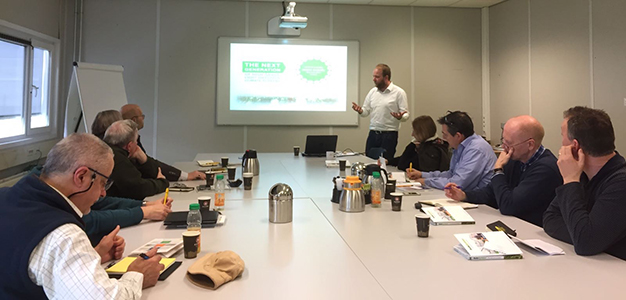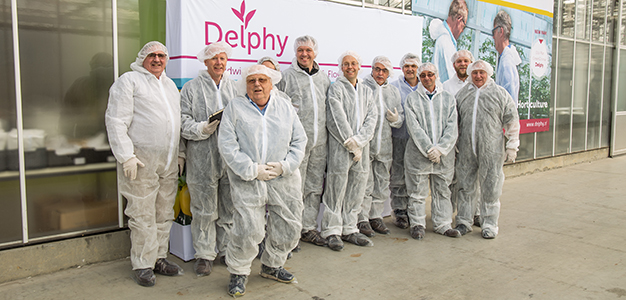英国种植者学习散射光和幕布知识
怎样才能帮助花卉种植者,资材供应商和种植技术人员获得幕布以及散射光相关的知识呢?斯文森正在行动!今年3月,斯文森的气候顾问Ton Habraken带领了一群英国客户参观了荷兰各种研究项目和一个蝴蝶兰种植温室。
散射光促进作物健康生长
散射型的Harmony幕布对于温室种植来说是非常理想的幕布类型。去年,斯文森推出了全新升级型的Harmony幕布,其散射水平进一步提升,位于温室结构阴影中的作物相比过去的Harmony幕布可以多获得32%的光照。光照更加柔和,均一,可以允许更多的散射光照进入温室。
在温室中,直射光线往往只能到达作物的冠层顶端,这会造成热应激和其它直射光带来的不利影响。比如,盆栽植物会很快干枯,由于作物顶端持续接受强烈的光照,温度过高而造成灼伤。“我测过盆栽的温度,在北面只有21°C (69.8°F),而南面会达到39°C (102.2°F)。”一个参观者告诉大家。这个问题可以由散射光解决,因为散射光分布的更加均一。
更多光照和适宜的温度
散射光可以照射到这个植株,因此作物的温度会比较接近周围的温度,底部的叶片也因为散射光而保持新鲜和活力。和直射光相比,散射光使得作物具有较高的光合效率,提高了光的利用率。而且,研究表明如果是散射光,红掌可以接受2倍高的光照量,缩短生长周期25%,增重20%。凤梨没有这种结果,但是单位产量有所提高。.
散射玻璃的散射水平较低,而全新Harmony幕布的散射水平更加理想和均一。开孔型的幕布降温效果更加明显。Ton Habraken告诉我们:“幕布的‘通风能力’甚至比温室的通风效果还强。”
新一代的青椒种植
荷兰Delphy公司的Improvement Centre测试了各种各样的幕布。英国种植者一同参观了新一代的青椒种植这个项目,这个项目的目的是提高青椒种植过程中的能源利用率,比如去年,有一个试验使用了斯文森双层幕布节能:上层的幕布(Luxous 1547 D FR)是具有散射特性的透明的保温幕布,下层的Luxous 1147 FR是现在市面上透光率最高的保温幕布,它可以在保持节能效果和水汽输送特性的前提下保证最高的透光率。得益于高透光的特性,幕布可以使用更长的时间,尤其是在白天。两层幕布的使用时间和节能目标都实现了,整个种植过程的天然气消耗量是17m3,而平时是35-40m3。青椒产量超过了平均产量,品质也非常好。
2017年,这个试验还会在重复进行一次,但是这次是使用3层Luxous 1147 FR,希望可以让天然气的使用量降到15m3。幕布的使用是新一代种植(NGG)的核心。Habraken说道:“如果大家对幕布感兴趣,我们可以一步一步来,不用一下实现全部,但是我们一定要学会利用幕布为我们服务。”

聚焦节能
这里菊花种植的研究项目主要着重于使用三层幕布来节约能源:阻光型的Obscura主要用来控制光周期,Luxous 1147 FR用来保温节能,Harmony幕布在白天提供23%的遮阳率。温室中还增加了LED补光,没有最低温度设定管的空气处理单元。
能源高效的利用希望在不影响作物品质的前提下比现在提高5%的产量;天然气使用量15 m3/m2/年,CO2使用量25 kg/m2/年。种植过程中使用了2种不同的灯:65 µmol/m2.s SON-T和100 µmol/m2.s LED红灯用来分析对于延迟开花的影响。
类似的试验还有散射玻璃下的玫瑰种植。以往使用能够产热的SON-T的进行补光,而现在已经试验出了针对玫瑰种植的含3种不同色彩配方的全LED光谱。
参观结束后,英国种植者对于Piko如何在不同的种植阶段使用不同的幕布来实现节能的优化表示印象深刻。

“With Svensson's newest climate screen, HARMONY 1315 O FR, lighting tomato growers can get through the worst of climates, even a record hot summer like in 2018,” says greenhouse climate consultant Joost Haenen.
The new open climate screen offers benefits not only for the plants, but also for the working climate conditions. The best part of this new screen is that it makes chalking or coating unnecessary.
The major challenge in every crop lies in the realization of a good assimilate balance. In other words, the production of assimilates (controlled by irradiation) and the consumption of assimilates (depending on temperature) must be in balance. During a heat wave such as our past summer, the temperature is high, and therefore the consumption of assimilates is high. Too high consumption of assimilates comes at the expense of the roots. Weak or uneven root growth can lead to quality problems and water stress during a heat wave with a lot of radiation, causing high evaporation. This will close the stomata. However, open stomata are necessary for CO2 absorption. As a result, not only growth comes to a halt, but also less moisture enters the greenhouse air. This can easily be avoided with the right ventilation strategy but preventing plant stress is even better. The Harmony 1315 O FR summer screen has been developed for this purpose.
Specially for exposed tomato cultivation
High light levels and air permeability are unique to the Harmony 1315 O FR summer screen. When closed, it provides a slight shadow effect (13% in direct light) and a very high diffusivity. The screen has been specially developed for illuminated tomato growing. Tomatoes can have a lot of light, but at some point, they can't handle it anymore. This climate screen has been developed to remove the sharp edges. Especially in the scarce warm months, April to July, when the plant is old and has long stems.
“Tests at the Improvement Center have shown that the plant does not have to evaporate as much on an extremely sunny day with the new screen. The water consumption is then approximately 20% lower, which means that the root quality remains better due to oxygen retention in the mat. The open structure is also unique, ensuring that there is more than enough air exchange. That's why it's a perfect screen for the summer," says climate consultant Joost Haenen. “Moreover, the cultivation plan changes from tomato. Lighting growers are planting plants earlier and earlier, sometimes in August or even in July. Small plants then have a hard time due to the high radiation and temperature. During this period, the climate screen can easily be used to keep the plant in balance."
存在疑问?
联系斯文森的咨询顾问